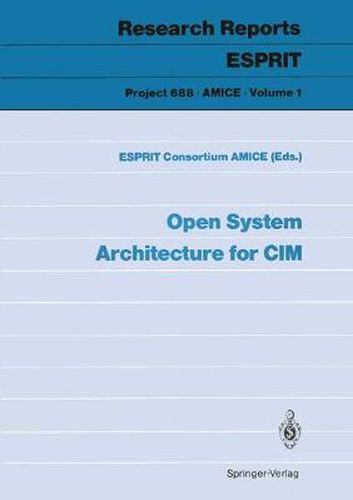Readings Newsletter
Become a Readings Member to make your shopping experience even easier.
Sign in or sign up for free!
You’re not far away from qualifying for FREE standard shipping within Australia
You’ve qualified for FREE standard shipping within Australia
The cart is loading…






On Integration computer applications have by now entered almost all enterprises, but mostly in an uncoordinated way without long term integration plans or automation strategies. Departments introduced computing equipment and purchased or developed programs to support their department operations. This approach divided an enterprise into small and almost autonomous enterprises, each with the goal to deploy the computer to make their department and its associated activities work more efficiently. Thus many departments acquired computers, developed and installed automation systems and PCs and educated their staff, announcing this was done to make the work force aware of the large benefits that computers bring. In this fashion the most important functions in an enterprise were more or less computerized (accounting more, CAM and CAD less). In 1986 Europe, the level of computerization in descending order of significance was as follows: Accounting, Inventory Control, Order Entry, Production Planning & Control, Purchasing, Distribution, Sales Planning, Shop Floor Control, Process Control, Quality Control, Manufacturing Engineering (including CAM), and finally Design Engineering (with CAD) [1]. The net result (something that dawned upon us after decades) was that the enterprise consisted of many II islands of ll automation * Moreover, these islands could even be found within departments, where specific functions had been computerized without regard to the impact on the remainder. In the late seventies it became clear that smooth transfer of information between enterprise activities and even within departments was a burden, if at all possible.
$9.00 standard shipping within Australia
FREE standard shipping within Australia for orders over $100.00
Express & International shipping calculated at checkout
On Integration computer applications have by now entered almost all enterprises, but mostly in an uncoordinated way without long term integration plans or automation strategies. Departments introduced computing equipment and purchased or developed programs to support their department operations. This approach divided an enterprise into small and almost autonomous enterprises, each with the goal to deploy the computer to make their department and its associated activities work more efficiently. Thus many departments acquired computers, developed and installed automation systems and PCs and educated their staff, announcing this was done to make the work force aware of the large benefits that computers bring. In this fashion the most important functions in an enterprise were more or less computerized (accounting more, CAM and CAD less). In 1986 Europe, the level of computerization in descending order of significance was as follows: Accounting, Inventory Control, Order Entry, Production Planning & Control, Purchasing, Distribution, Sales Planning, Shop Floor Control, Process Control, Quality Control, Manufacturing Engineering (including CAM), and finally Design Engineering (with CAD) [1]. The net result (something that dawned upon us after decades) was that the enterprise consisted of many II islands of ll automation * Moreover, these islands could even be found within departments, where specific functions had been computerized without regard to the impact on the remainder. In the late seventies it became clear that smooth transfer of information between enterprise activities and even within departments was a burden, if at all possible.